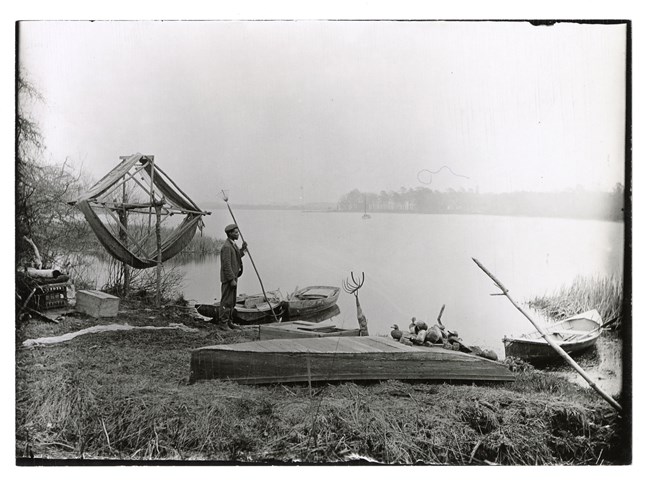
NPS/FIIS Archive The history of life on Long Island does not begin with colonial settlement, but instead with the indigenous people who have called this land home for thousands of years. Since long before the arrival of European colonizers, Indigenous Long Islanders of the Unkechaug, Secatogue, and Shinnecock tribes have shaped the historical, cultural, and natural landscape we all continue to enjoy today. For many centuries sites at Fire Island National Seashore, including the barrier beach and the William Floyd Estate, have played a critical role in indigenous life. Whether as sites for the harvesting of natural resources, seasonal settlement, or sacred grounds, these places were, and continue to be, the ancestral home of many Americans.
Though centuries of colonization and outright repression have disposed many Indigenous Long Islanders of their land, many continue to act as stewards of Fire Island and Long Island’s rich natural and cultural history. The ancient settlement “Poospatuck ,”meaning “a little river that flows into tidal waters,” was established by ancestral Unkechaug along Poospatuck Creek, which flows into the Forge River and out into Moriches Bay. Now the site of the Unkechaug reservation, the location gave Native people easy access to fish, shellfish, waterfowl, and sea mammals including seals and whales. Poospatuck’s location along the Forge River provides easy access to the Great South Bay and to Fire Island. Today Poospatuck remains the ancestral home of the Unkechaug people. It is among the oldest Native American reservations in the United States and is formally recognized by New York State SnapshotsThe gallery below features a selection of informal snapshots taken by Floyd family members and documentary photographs taken by biologist Francis Harper. They offer a glimpse into the lives of Unkechaug people from the Poospatuck Reservation at the turn of the 20th century. It was a period of transition from skilled day labor on the estates of white landed gentry to employment in the shipping and hospitality industries. Poverty was a constant challenge. With barriers to homeownership on the reservation, Unkechaug from neighboring towns came back to a community centered around the Poospatuck school and the reservation church. Chief Lone Otter explained: "We walk three paths—that of modern society, with its progressive education; that of the Christian spiritual world; and [that of] the Native American World with its ancient spirituality. One goal remains the same: to maintain our identity as Native Americans." -- Donald Treadwell (Lone Otter), 1988, qtd. in John A. Strong, The Unkechaug Indians of Eastern Long Island Learning more about Native American HeritageWe would like to encourage you to learn about this incredible history and heritage. Consider reading Indigenous resources, such as “On This Site”, a project by Long Island Artist and Shinnecock Nation Tribe member Jeremy Dennis, for a look at local Indigenous history here on Long Island. Learn more about how the NPS is sharing Indigenous stories: https://www.nps.gov/subjects/americanindians/index.htm |
Last updated: October 23, 2021
